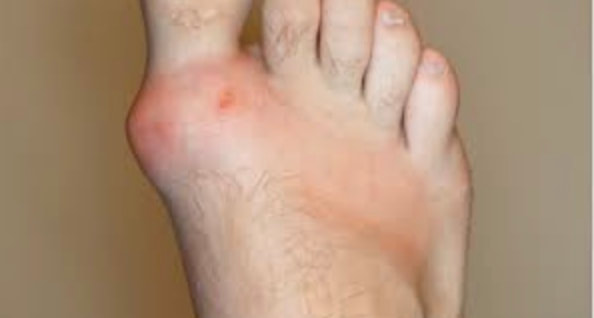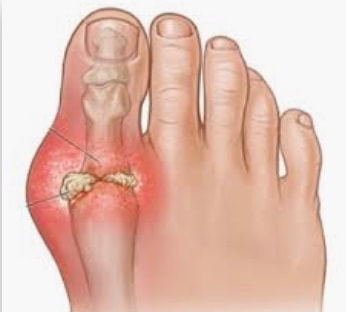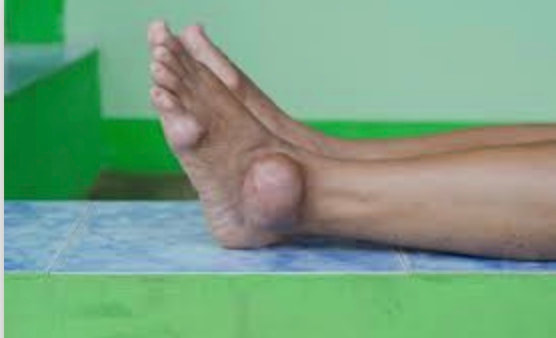GOUT
What's The Problem?Gout is a genetic or acquired disease where uric acid crystals, a waste product of protein metabolism, is deposited in joints, producing an intense inflammatory arthritis.
How Does It Feel?
An acute attack of gout is one of the most painful conditions known to man. Sudden, intense throbbing pain accompanied by redness and swelling are hallmarks of the condition. 50% of all acute attacks of gout affect the big toe joint. Gout is a disease that appears as episodes or attacks. Even without treatment, the attacks last only 3-5 days, but the pain is often so severe, that waiting for it to run it's course is often not possible.
Let's Do A Test
X-rays of the affected joint may show swelling, and in long standing gouty arthritis, destruction of the joint. After years of repeated gout attacks, uric acid crystals may also be seen as faint yellowish masses visible through the skin around the affected joint. Blood tests may show an elevated uric acid level, but about 50% of people with acute gout have a normal uric acid. Inmost gout attacks, the level of uric acid peaks quickly and drops back to normal just as quickly. The symptoms actually begin to be felt when the level is already dropping. By the time the patient his seen in the doctor's office and the blood level of uric acid is measure, the level is often back to normal. The gold standard for diagnosis is to remove a sample of joint fluid and look for the uric acid crystals under the microscope. However, it is difficult to collect the joint fluid from the small foot joints and this test is often bypassed. There is a medicine that is used today that is so effective when used to treat an acute gout attack, that giving this medicine is now used as a reliable way to diagnose gout. If the pain goes away after taking less than 3 doses of the medicine, within a day, then the condition was most likely a true gout attack.
How Did This Happen?
Gout may be inherited or acquired. Proteins that we eat are broken down into energy and waste products. One of the waste products is uric acid. Uric acid is usually dissolved in the blood and filtered out by the kidneys. Some people either produce too much uric acid or do not excrete enough through the kidneys. If blood levels rise, uric acid is deposited in joints, producing an acute attack. The unique properties of uric acid and the conditions in the small foot joints, including the temperature and pressure, create an environment that allows the uric acid to crystallize and deposit in the joints, creating an intense inflammatory response. Factors that may trigger a gout attack are a minor injury to a foot joint, overindulgence in alcohol or purine rich foods, and stress, both emotional and physical.
What Can I Do For It?
The application of warm moist compresses may give some relief of symptoms. Historically, gout was treated by changing the patient's diet to reduce intake of protein, but we have come to believe that the reduction of protein needs to be so complete, that the diet is otherwise unhealthy, so diet alteration is no longer stressed with the exception noted below. We do know that regular alcohol use is a strong trigger for a gout attack, so reduction in this habit is recommended.
What Will Dr. Karr Do For It?
In most cases medication will provide relief of the symptoms of gouty arthritis, however in more extreme cases, your podiatrist may recommend surgery to remove gouty deposits and remodel the affected joint. The anti-inflammatory medicine Indocin (Indomethacin) is so effective when used to treat gout, that after taking 1-3 doses, usually 50 mg after each meal, that the pain has gone. A dull ache may linger for a few days later, and a cortisone injection may be recommended to eliminate this pain a bit sooner. If a patient experiences repeated attacks, 3 in a 12 month period, the doctor will recommend taking a medication called Xyloprim (Allopurinol) to lower the level of uric acid in the blood. This medication is then taken routinely. A steroid injection into the effected joint helps significantly.
Can I Prevent It From Happening Again?
Gout can often be prevented with medication, some diet modification, and avoidance of triggers, like alcohol. Purine-rich organ meats such as liver, kidney and brain should be avoided as well as shellfish. Dr. Karr can provide a treatment program tailored to your individual condition.
What's The Problem?Gout is a genetic or acquired disease where uric acid crystals, a waste product of protein metabolism, is deposited in joints, producing an intense inflammatory arthritis.
How Does It Feel?
An acute attack of gout is one of the most painful conditions known to man. Sudden, intense throbbing pain accompanied by redness and swelling are hallmarks of the condition. 50% of all acute attacks of gout affect the big toe joint. Gout is a disease that appears as episodes or attacks. Even without treatment, the attacks last only 3-5 days, but the pain is often so severe, that waiting for it to run it's course is often not possible.
Let's Do A Test
X-rays of the affected joint may show swelling, and in long standing gouty arthritis, destruction of the joint. After years of repeated gout attacks, uric acid crystals may also be seen as faint yellowish masses visible through the skin around the affected joint. Blood tests may show an elevated uric acid level, but about 50% of people with acute gout have a normal uric acid. Inmost gout attacks, the level of uric acid peaks quickly and drops back to normal just as quickly. The symptoms actually begin to be felt when the level is already dropping. By the time the patient his seen in the doctor's office and the blood level of uric acid is measure, the level is often back to normal. The gold standard for diagnosis is to remove a sample of joint fluid and look for the uric acid crystals under the microscope. However, it is difficult to collect the joint fluid from the small foot joints and this test is often bypassed. There is a medicine that is used today that is so effective when used to treat an acute gout attack, that giving this medicine is now used as a reliable way to diagnose gout. If the pain goes away after taking less than 3 doses of the medicine, within a day, then the condition was most likely a true gout attack.
How Did This Happen?
Gout may be inherited or acquired. Proteins that we eat are broken down into energy and waste products. One of the waste products is uric acid. Uric acid is usually dissolved in the blood and filtered out by the kidneys. Some people either produce too much uric acid or do not excrete enough through the kidneys. If blood levels rise, uric acid is deposited in joints, producing an acute attack. The unique properties of uric acid and the conditions in the small foot joints, including the temperature and pressure, create an environment that allows the uric acid to crystallize and deposit in the joints, creating an intense inflammatory response. Factors that may trigger a gout attack are a minor injury to a foot joint, overindulgence in alcohol or purine rich foods, and stress, both emotional and physical.
What Can I Do For It?
The application of warm moist compresses may give some relief of symptoms. Historically, gout was treated by changing the patient's diet to reduce intake of protein, but we have come to believe that the reduction of protein needs to be so complete, that the diet is otherwise unhealthy, so diet alteration is no longer stressed with the exception noted below. We do know that regular alcohol use is a strong trigger for a gout attack, so reduction in this habit is recommended.
What Will Dr. Karr Do For It?
In most cases medication will provide relief of the symptoms of gouty arthritis, however in more extreme cases, your podiatrist may recommend surgery to remove gouty deposits and remodel the affected joint. The anti-inflammatory medicine Indocin (Indomethacin) is so effective when used to treat gout, that after taking 1-3 doses, usually 50 mg after each meal, that the pain has gone. A dull ache may linger for a few days later, and a cortisone injection may be recommended to eliminate this pain a bit sooner. If a patient experiences repeated attacks, 3 in a 12 month period, the doctor will recommend taking a medication called Xyloprim (Allopurinol) to lower the level of uric acid in the blood. This medication is then taken routinely. A steroid injection into the effected joint helps significantly.
Can I Prevent It From Happening Again?
Gout can often be prevented with medication, some diet modification, and avoidance of triggers, like alcohol. Purine-rich organ meats such as liver, kidney and brain should be avoided as well as shellfish. Dr. Karr can provide a treatment program tailored to your individual condition.



